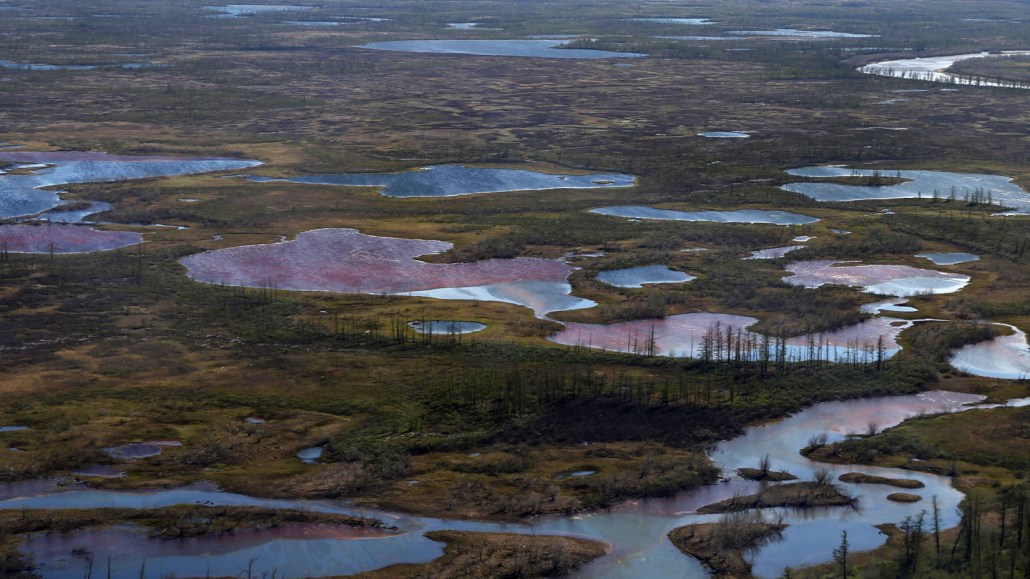
In May 2020, more than 20,000 metric tons of diesel fuel spilled from a destabilized tank facility in northern Siberia, contaminating an area roughly the size of Philadelphia. The spill was blamed partly on the loss of soil stability in thawed permafrost.
IRINA YARINSKAYA/AFP via Getty Images Plus
As the Arctic’s icebound ground warms, it may unleash toxic substances across the region.
By the end of the century, the thaw threatens to destabilize facilities at more than 2,000 industrial sites, such as mines and pipelines, and further compromise more than 5,000 already contaminated areas, researchers report March 28 in Nature Communications.
Those numbers come from the first comprehensive study to pinpoint where Arctic permafrost thaw could release industrial pollutants. But there are probably even more contaminated areas that we don’t know about, says permafrost researcher Moritz Langer of the Alfred Wegener Institute in Potsdam, Germany. “We only see the tip of the iceberg.”
Toxic substances released from these locations could jeopardize fish and other animals living in Arctic waterways, as well as the health of people who depend on them.
Permafrost is any soil, sediment or rock that remains frozen for at least two years. Step on the ground in the Arctic and chances are that permafrost lies underfoot. For decades, people have treated the frozen earth as staunch and largely immobile. Industries constructed infrastructure atop its firmness, and within it they buried their refuse and sludge. In some places, scientists and others have used permafrost to store radioactive waste.
But the Arctic is warming nearly four times as fast as the rest of the planet as a result of climate change, and as much as 65 percent of the region’s permafrost may disappear by 2100 (SN: 8/11/22).
That could release some worrisome things, says climate scientist Kimberley Miner of NASA’s Jet Propulsion Laboratory in Pasadena, Calif., who wasn’t involved in the study. In 2021, Miner and her colleagues warned that the thawing of Arctic permafrost could release antibiotic-resistant bacteria, viruses and radioactive waste from nuclear-testing programs into the environment.
Keen to identify where the warming could spread industrial pollutants, Langer and his colleagues first analyzed the range of Arctic permafrost and whereabouts of industrial infrastructure. They identified about 4,500 sites — including oil fields, mines and abandoned military installations — in places where permafrost probably exists. Next, the team used contamination data from Alaska and Canada — regions with accessible records — and found that as of January 2021, about 3,600 contaminated locations occupy the two regions. These include waste areas and places where pollutants were accidentally released.
Realistically, these numbers are probably deflated, Langer says, because many incidents of contamination have probably gone undocumented.
Focusing on Alaska, the researchers found that diesel, gasoline and related petrochemicals make up about half of the pollutants reported. Lead, arsenic and mercury — substances toxic to fish, people and other organisms — were reported too. But in many cases, the type of pollutant was not documented. “That’s a big problem,” Langer says, in part because it makes understanding the risks of a particular leak or spill much harder.
Using the locations of industrial sites and North American contamination data, Langer and colleagues extrapolated where industrial contamination and permafrost might coexist across the entirety of the Arctic, finding 13,000 to 20,000 such sites may exist today. Then, they used computer simulations to investigate the impact of current and future levels of climate change.
Today, there may already be a risk of permafrost degrading at about 1,000 of the known industrial sites and 2,200 to 4,800 of the known and estimated contaminated locations, they found.
In a low-emissions scenario in which warming rises by up to 2 degrees Celsius above preindustrial levels by the end of the century, those numbers increase to more than 2,100 industrial sites and 5,600 to 10,000 contaminated areas. An increase of about 4.3 degrees C would probably affect almost all the known and projected locations.
“We’re going to need to think about keeping [pollutants] where they need to be,” Miner says, “not just leaving them on the landscape where we feel like.”
The new findings are probably conservative, Langer says, partly because the analysis didn’t consider that infrastructure itself can warm the ground. What’s more, even if it doesn’t fully thaw, “warming of the permafrost causes quite a bit of problem,” says civil engineer Guy Doré of Université Laval in Quebec City, who wasn’t involved in the study. Permafrost that warms from –5° C to –2° C can lose half of its load-bearing capacity, he says, destabilizing infrastructure.
Today, no international regulations mandate industries in the Arctic to document the substances they use and store, or what happens to them. Without that information, Langer says, it’ll be difficult to assess and manage the growing risk of contamination.
He plans to visit decades-old oil drilling facilities in Canada to study how the changing permafrost has affected the containment of drilling fluids. “That’s the next step,” he says, “to understand better how [industrial contaminants] spread into the landscape.”







